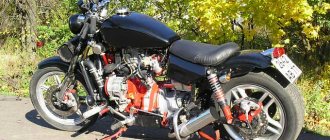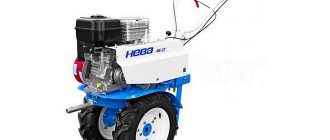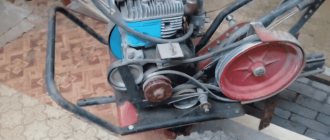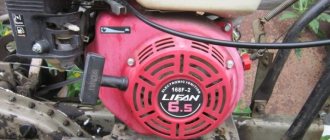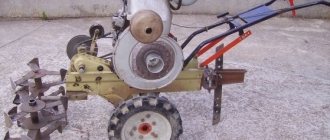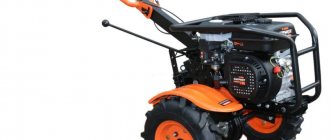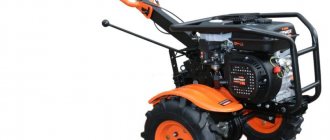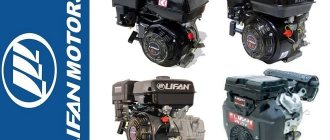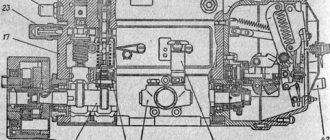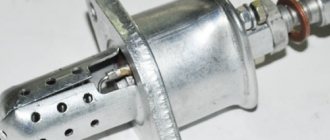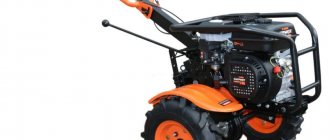Ural with ZiD engine
Small batches of motor blocks were equipped with a ZiD-4.5 brand power unit. The design of the engine is not much different from the UMP-5V. The crankshaft has a pulley and a sprocket to drive the chain. The pulley is located on the flywheel side, the chain drive is on the pinion side. The chain drive is used to control stationary installations. The engine is lubricated by splashing; oil is supplied by a plunger pump from a sump containing 1.5 liters of fluid.
A belt drive is used to transmit torque from the engine to the transmission. The belt for the walk-behind tractor has a size of 11201711 mm. The walk-behind tractor uses a 2-speed gearbox, the design and control of which are similar to machines with a UMZ-5V engine. The gearbox has 2 speeds, which reduce the rotation speed by 17 and 7 times, respectively. Switching speeds is done using a handle. Before starting to operate the engine unit, it is necessary to check the level and top up the transmission oil in the gearbox. The rated capacity of the crankcase is 1.5 liters.
The engine ignition system includes a magnetic circuit that ensures constant ignition timing. As wear occurs, the angle changes, resulting in unstable ignition. To adjust the ignition of the engine block, it is necessary to control the moment when the switch contacts open and the maximum gap between them. The test is performed by removing the flywheel by aligning the notch on the crankshaft with the notch on the base of the magnetic armature.
The power system includes a K16N or ZiD-12 carburetor and a fuel tank containing 8 liters of gasoline. Adjusting the carburetor walk-behind tractor allows you to ensure uniform engine operation and fuel consumption as stated by the factory. The adjustment is made with the engine warm by turning the idle speed screw and the throttle travel lock screw. In this way, the minimum idle speed is adjusted.
Specifications
According to the operating instructions for the Ural walk-behind tractor, the product consists of a frame made of steel profile. The frame is equipped with a power unit, a clutch mechanism and an additional 2-speed gearbox. The power unit is installed through rubber shock absorbers that reduce vibration on the controls.
For movement, 2 wheels are used. The walk-behind tractor uses solid rubber tires with a diameter of 430 mm and a width of 110 mm. Fixed track width - 540 mm. The walk-behind tractor is controlled by handles attached to the frame. The handles are used to turn, change engine speed and change gears. The steering can be adjusted depending on the height of the operator. A bar with holes is used for adjustment.
Motoblock dimensions:
- length - 1880 mm;
- width - 690 mm;
- height - 1280 mm.
On the front of the frame there is a pin used for installing attachments. The pin is housed in a steel housing bolted to the cross member. There are 2 holes in the body of the pin through which attachments are secured. On the rear cross member there is a bracket designed for installing towed equipment.
The engine installed on the walk-behind tractor requires regular maintenance with partial or complete disassembly. After 250 hours of operation, the valves need to be ground in and adjusted. There are marks on the gears to set the valve timing. Adjustment of the gap between the pushers and valves is carried out using a special screw located at the end of the pusher.
The manufacturer allows a variation in the length and height of products within 50 mm, and in width - within 20 mm. The weight of the equipped device is 120 kg, the weight of the towed trailer is 350 kg. The maximum speed is 11.5 km/h. For the fastest possible movement, a combination of the highest gear in the engine and higher speed in the additional gearbox is used.
Modern walk-behind tractors with disc drive
For Chinese walk-behind tractors with disc clutches, engines are used for splines (not for keys!). Such engines are much less common than engines with a key.
However, in our store there are such engines, although, of course, the choice is much smaller than among engines with a key.
To select an engine for a walk-behind tractor with a disc clutch you need:
- Measure the shaft diameter on an old engine (usually there is a 25 mm shaft, but sometimes 20 mm is found on 7 hp engines)
- Select the engine for the splines according to the following rules:
- If you had an engine up to 7 hp, then choose 7 hp (don't forget to check the shaft diameter!)
- If you had a 9 hp engine, then choose 9 ds
- If you had an engine from 11 hp, then choose any engine with 11, 13, 15 or 17 hp
How to install a Lifan engine on a walk-behind tractor
Each model and class of walk-behind tractor has its own engine. Let's look at these examples:
- The Ugra NMB-1N7 walk-behind tractor with a Lifan engine corresponds to version 168F-2A in terms of technical characteristics.
- Motoblock Salyut 100 - version 168F-2B.
- Ugra NMB-1N14 middle class - Lifan 177F engine with a power of 9 hp. With.
- Agat equipment with a Lifan engine can be equipped with models 168F-2 and Lifan 177F.
- An Oka with a Lifan 177F engine when combined with attachments will work better and more efficiently. Model 168F-2 with a power of 6.5 liters. With. also suitable for Oka MB-1D1M10S walk-behind tractor with Lifan engine
The engine can be installed on walk-behind tractors Ural, Oka, Neva according to the following algorithm of actions:
- Remove the protective casing from the old engine, belts, pulley, while unscrewing the bolts.
- Remove the air purification filter to disconnect the throttle cable.
- Remove the engine from the walk-behind tractor frame.
- Install the motor. If necessary, a transition platform is installed.
- A pulley is attached to the shaft, a belt is tightened for better operation of the track, adjusting the position of the motor.
- Secure the transition platform and the engine.
When installing the motor, the user must take care of the installation equipment.
Motoblock Cascade
When installing an imported Lifan engine on a domestic one, the following additional parts are required:
- pulley;
- transition platform;
- adapter washer;
- throttle cable;
- crankshaft bolt;
- fasteners.
The mounting holes on the frame do not line up. For this purpose, a transition platform is purchased.
The cascade is equipped with a domestic engine DM-68 with a power of 6 hp. With. When replacing the engine with a Lifan, choose model 168F-2.
Motoblock Mole
When installing a Lifan engine equipped with an old domestic engine, replacement requires installation kits, which include elements such as:
- pulley;
- adapter washer;
- throttle cable;
- crankshaft bolt.
If there was an imported motor on the walk-behind tractor, then only the Lifan engine itself with an output shaft diameter of 20 mm is sufficient for installation.
Specifications
Gasoline engine models are excellent for walk-behind tractors - Lifan 168F, 168F-2, 177F and 2V77F.
Model 168F belongs to the group of engines with a maximum power of 6 hp. With. and is a 1-cylinder 4-stroke unit with forced cooling and a crankshaft positioned at an angle of 25°.
The technical characteristics of the engine for the walk-behind tractor are as follows:
- Cylinder volume - 163 cm³.
- Fuel tank volume - 3.6 liters.
- Cylinder diameter - 68 mm.
- The piston stroke is 45 mm.
- Shaft diameter - 19 mm.
- Power - 5.4 l. s. (3.4 kW).
- Rotation speed - 3600 rpm.
- Startup is manual.
- Overall dimensions - 312x365x334 mm.
- Weight - 15 kg.
The 168F-2 model is of particular interest to walk-behind tractor users, as it is a modification of the 168F motor, but has an increased service life and higher parameters, such as:
- power - 6.5 l. With.;
- cylinder volume - 196 cm³.
The cylinder bore and stroke are 68 and 54 mm, respectively.
Of the 9 hp engine models. With. highlight the Lifan 177F, which is a 1-cylinder 4-stroke gasoline engine with forced air cooling and a horizontal output shaft.
The main technical parameters of Lifan 177F are as follows:
- Power - 9 l. With. (5.7 kW).
- Cylinder volume - 270 cm³.
- Fuel tank volume - 6 l.
- The diameter per piston stroke is 77x58 mm.
- Rotation speed - 3600 rpm.
- Overall dimensions - 378x428x408 mm.
- Weight - 25 kg.
The Lifan 2V77F engine is a 2-piston V-shaped 4-stroke overhead valve gasoline engine with forced air cooling, a contactless transistor magneto ignition system and a mechanical speed controller. In terms of technical parameters, it is considered the best of all heavy class models. Its characteristics are as follows:
- Power - 17 liters. With. (12.5 kW).
- Cylinder volume - 614 cm³.
- Fuel tank volume - 27.5 l.
- Cylinder diameter - 77 mm.
- The piston stroke is 66 mm.
- Rotation speed - 3600 rpm.
- Starting system - electric, 12 V.
- Overall dimensions - 455x396x447 mm.
- Weight - 42 kg.
The service life of the professional engine is 3500 hours.
Fuel consumption
For engines 168F and 168F-2, fuel consumption is 394 g/kWh.
Models Lifan 177F and 2V77F can consume 374 g/kWh.
As a result, the estimated duration of work is 6-7 hours.
The manufacturer recommends using AI-92(95) gasoline as fuel.
Traction class
Light walk-behind tractors of traction class 0.1 are units up to 5 liters. With. They are purchased for plots of up to 20 acres.
Medium walk-behind tractors with power up to 9 hp. With. cultivate areas up to 1 hectare, and with heavy walk-behind tractors 9-17 liters. With. traction class 0.2 cultivate fields up to 4 hectares.
Lifan 168F and 168F-2 engines are suitable for Tselina, Neva, Salyut, Favorit, Agat, Cascade, Oka vehicles.
The Lifan 177F engine can also be used for installation on medium-sized vehicles.
The most powerful gasoline unit Lifan 2V78F-2 is designed for work in difficult conditions on mini tractors and heavy walk-behind tractors, such as Foreman, Sadko, Don, Profi, Plowman.
Installation of a Chinese engine on a Ural walk-behind tractor
Greetings dear forum members. There is a similar topic here somewhere, or rather it is generally about the Urals, and in it the topic of engine replacement is touched upon without any specific examples (except perhaps for a few videos on YouTube, where a specific installation is briefly covered without details and with advertising). I got the gist from it, but some details remained questionable. Here I will outline my installation experience, not without your help, of course. At the moment there is a Ural walk-behind tractor with an almost inoperative EVP engine/
A single-stage reduction gearbox was purchased for engines with a 19.05 mm shaft
A Green Field GF-170FE 4-stroke gasoline engine has been ordered (with an electric starter, this is my father’s requirement, since it is calculated that the walk-behind tractor will be used with a cart for trips to pick up grass for rabbits)))
Now the matter remains with the pulley for the gearbox and belts. But I will buy belts after installing the engine, fortunately in the city there is a factory for the production of rubber products UZEMIK and a company store attached to it, choosing belts will not be a problem. It's not entirely clear with the pulley. The original pulley from the Urals has a 32mm shaft fit. The shaft of the new gearbox is 15mm. Making a spacer is not difficult. But. I found a passport for the Ural walk-behind tractor on this forum, one of the forum members scanned it, for which I thank him very much. So, the speed of the gearbox shaft at 1 speed is about 300 rpm, at 2,600 rpm. The speed of the Chinese engine is up to 3600 rpm, with a new gearbox 1800 rpm, i.e. somewhere 3-6 times more than necessary (provided that the original pulley from the Urals is installed), i.e. change the pulley too. For now there are two options - order a new one, or get one from a Mole motor-cultivator, like this
Unfortunately, I haven’t measured the dimensions of the original pulley, and I also can’t find the dimensions of the Mole pulley, so I’m still in creative search. I would be very grateful to everyone for useful thoughts or experience in this homemade product. P.S. The engine will be installed in any case, I will make detailed instructions on what I did and how, so that people don’t suffer like I did in finding the necessary material.
Where did you buy this miracle and how much, if it’s not a secret? PS: Hello fellow countrymen!
However, when I ordered a week ago, there were only two left. write to them by email. They sent it to me via business lines, quickly. its main feature is that it changes the direction of rotation from left (as on all modern engines) to right (and in the Urals it is clockwise). the most optimal way, or drive backwards)))
I will continue my research, I found a ready-made pulley with a 15mm seat, but it is not available for order.
A single-stage reduction gearbox was purchased for engines with a 19.05 mm shaft
A Green Field GF-170FE 4-stroke gasoline engine has been ordered (with an electric starter, this is my father’s requirement, since it is calculated that the walk-behind tractor will be used with a cart for trips to pick up grass for rabbits)))
Now the matter remains with the pulley for the gearbox and belts. But I will buy belts after installing the engine, fortunately in the city there is a factory for the production of rubber products UZEMIK and a company store attached to it, choosing belts will not be a problem. It's not entirely clear with the pulley. The original pulley from the Urals has a 32mm shaft fit. The shaft of the new gearbox is 15mm. Making a spacer is not difficult. But. I found a passport for the Ural walk-behind tractor on this forum, one of the forum members scanned it, for which I thank him very much. So, the speed of the gearbox shaft at 1 speed is about 300 rpm, at 2,600 rpm. The speed of the Chinese engine is up to 3600 rpm, with a new gearbox 1800 rpm, i.e. somewhere 3-6 times more than necessary (provided that the original pulley from the Urals is installed), i.e. change the pulley too. For now there are two options - order a new one, or get one from a Mole motor-cultivator, like this
Unfortunately, I haven’t measured the dimensions of the original pulley, and I also can’t find the dimensions of the Mole pulley, so I’m still in creative search. I would be very grateful to everyone for useful thoughts or experience in this homemade product. P.S. The engine will be installed in any case, I will make detailed instructions on what I did and how, so that people don’t suffer like I did in finding the necessary material.
Somehow, there is a problem with the numbers, since the gearbox, the clutch reduces the speed by 2 and it turns out to be almost 1800 rpm, then the gearbox pulley, the MB gearbox. Anuriev's reference book, volume 2, will help you with calculations. I deleted my browser, and there was a link to engines with gearboxes, to MB Favorit and Ural.
Engine for MTZ walk-behind tractor (Soviet engine)
MTZ walk-behind tractors are still produced in Belarus to this day. But modern MTZ walk-behind tractors have a slightly different structure than Soviet ones - and most importantly, they are produced only with foreign engines (mainly Honda and Weima).
For the most common models of MTZ walk-behind tractors (MTZ-05, MTZ-06 and MTZ-012) there is a special adapter:
Adapter for MTZ walk-behind tractor (Belarus) for installing a modern engine
Together with this adapter, any modern Lifan/Honda type engine with a 25 mm shaft and the required flange will suit you. You can view all suitable engines we have here.
Answers to common questions:
- Will it work with a 9 hp engine (Lifan 177F)? Very often on the Russian market, 9 hp engines come with a non-standard bolt pattern on the cover for the Ugra walk-behind tractor. Such an engine will not simply fit onto the adapter. But if you have an engine version with a standard bolt pattern, then it will do. How to understand which flange? It’s easier to buy a 13-15 hp engine, they are a little more expensive than 9 horsepower.
- Why is it so expensive? Adapters at MTZ are produced to order by literally one small enterprise throughout Russia.
Advantages and disadvantages
Based on reviews of the Ural walk-behind tractor model range, a number of advantages can be identified:
- The weight of the product is 120 kg, so during operation there is no need to exert additional physical force on the control handles;
- possibility of alteration and modernization;
- the engine on the Ural walk-behind tractor with gearbox has a long service life;
- an effective air purifier that does not require replacement of filter elements;
- simplicity of design and the possibility of self-repair.
Owners note the following disadvantages:
- oil leaks at the joints of engine parts and gearbox;
- the need to check the oil level;
- increased fuel and engine oil consumption due to the design of the gas distribution mechanism;
- The walk-behind tractor is not suitable for long trips with a trailer due to the low speed.
Classes
According to their traction characteristics, walk-behind tractors are divided into classes.
In conclusion, we can say that today’s market offers different engines for walk-behind tractors, both Russian and imported, and in many cases they are interchangeable.
How to install the Lifan 168f-2 engine on the Ural walk-behind tractor, watch the video.
Source
Modern walk-behind tractors with belt drive
In order to select an engine for a modern walk-behind tractor with a chain drive, you need:
- Measure the shaft diameter on an old engine (it will be either 19.05 or 20 mm, less often - 25 mm on 9 horsepower engines)
- Select a new motor with the same shaft size as the old motor
Clue:
If you had an engine with a 19.05 mm shaft, and you want to take a new one with a 20 mm shaft or vice versa, then:
- Take a new engine with the required shaft
- Buy a new pulley to fit the shaft size of the new engine (pulley 19.05 mm, pulley 20 mm)
Also, buying a new pulley is a good option if it is not possible to measure the shaft diameter on the old engine.
Answers to common questions:
- Will the mounts from the old engine work? Yes, they will fit
- My engine was weak, I want to install a more powerful one. If you want a simple option without modifications, then it is best to take the Lifan 170F-T (8 l) - this is the most powerful Lifan engine with a 20 mm shaft.
- I had a weak engine, I want to install a much more powerful engine (13 hp, for example). In this case, in addition to buying a new pulley, you will also have to redo the engine seat. The task is not very simple, and the gearbox will receive loads for which it was not designed.
Description
The description of the Ural Patriot walk-behind tractor should begin with the fact that this machine was assembled by a defense enterprise from Bashkiria called TsMPO JSC. This is one of the best examples of the transfer of military production to civilian lines.
Ural walk-behind tractors have a low price and high quality
The walk-behind tractor gained its popularity due to its ease of operation and high maintainability. This car can be repaired on the go, and there are no problems with access to spare parts.
Main features of the Urals:
- cultivate areas up to a hectare;
- the capabilities are not limited only to soil cultivation - it is capable of removing snow and transporting loads when using the proper attachments;
- the device’s transmission is equipped with four gears;
- thanks to a maximum speed of up to 15 kilometers per hour, it is well suited for transporting goods in conditions of poor or no roads;
- has increased stability due to the width of the wheelbase;
- It is possible to adjust the track based on operating conditions, which significantly increases the efficiency of the unit.
Attention! Models of the Ural walk-behind tractor are equipped with both domestically produced and foreign engines. The choice of one option or another depends entirely on the preferences and budget of the consumer.
In this video we will review the Ural walk-behind tractor:
Motor problems
Engines running on different types of fuel (gasoline or diesel) have different service life. For engines using diesel fuel, it is much larger, but it is gasoline units that are popular due to their lower cost and ease of operation and repair.
Typically, of all faults, two main types can be distinguished:
- startup problems;
- problems with smooth operation.
Problems in the fuel system
The first thing you need to do is check the spark plugs. If they are dry, this may mean that gasoline is not getting to the engine. The main reasons will be: lack of fuel, the supply valve was closed, the hole in the tank plug is clogged, unnecessary objects get into the fuel system.
For maintenance you should:
- refuel the walk-behind tractor;
- unscrew the fuel supply valve;
- clean the gas tank cap;
- remove all gasoline from the tank, having first removed the fuel valve, and wash it with clean fuel. Then blow out the jets in the carburetor using the fuel supply pump.
When the candles are left wet
The following malfunctions are identified:
- The appearance of carbon deposits on the spark plugs. They should be cleaned with a rough surface and washed.
- The gap between the electrodes has been increased or decreased. You need to adjust it to the required size.
- Wiring insulation is damaged. It is usually replaced with a new one.
- There is a ground short to the STOP button.
- The ignition system starter is faulty.
The rubber carburetor seals may also become loose, causing air to be sucked in. It is necessary to tighten the bolts, spark plugs and inspect the gaskets between the cylinder and the spark plug head.
Choosing an engine for a cultivator
Unlike walk-behind tractors, which can be used together with an active hitch, walk-behind cultivators are used only for cultivating land. They usually don't have wheels.
Engine for motor cultivator Mole
The Mole cultivator was produced in the USSR, but now neither the Mole cultivator itself nor the engines for it are produced. But it's not a problem.
For Mole you will need:
- Modern engine of the Lifan/Honda type with a 19.05 or 20 mm shaft
- Special new pulley for Mole under the shaft of the new engine (for 19.05 mm and for 20 mm)
- New belt A750
Answers to common questions:
- What power should I take for the new engine? An engine up to 8 hp with a 19.05 or 20 mm shaft will suit you. But we would advise staying at 6.5 hp; more powerful is not necessary.
- Wouldn't the old pulley work? No, it was for a different shaft diameter.
- Why is the pulley double-grooved? There are Mole models with reverse speed, so special pulleys for Mole are always made with 2 grooves.
- I want to take a 3 or 4 hp engine. 3 or 4 hp engines exist in nature, but are non-standard. And therefore they will cost more than the widely used 6.5 horsepower engines. Better take 6.5 hp.
Adviсe:
- It’s better to take 4-6 belts at once. They are cheap, but not sold in every store.
- There are a lot of instructions on YouTube for converting the Mole to a new engine. For example, here and here.
Motoblock "Ural"
Motoblocks "Ural-UMP-5V" first began to be sold in the country just before its global redistribution at the dawn of the 90s of the last century. Since many people needed walk-behind tractors as a convenient and cheap technical tool, it became very popular in the USSR. In just a few years, its sales reached 150 thousand units. The optimal combination of its characteristics contributed to the popularity of the walk-behind tractor.
The walk-behind tractor has a wide adjustable ground clearance, which allows the device to be used in different types of areas. But it is worth noting that the basic Ural model is not particularly multifunctional. It can only transport cargo and cultivate the soil. It will not be possible to mow grass, remove debris or snow using attachments with this type of equipment - such capabilities are not provided. But if you remake the design yourself, adding the necessary fastening units, you can expand its functionality.
The model is implemented according to the scheme of transferring power to the wheels via a differential. Some modifications use foreign high-power engines, but domestic options are the most popular due to the availability of spare parts, proper documentation and durability.
Video review
The Ural UMZ 5V has a wide track, which the owner can customize based on operating conditions and type of terrain. This function allows the equipment to become easier to use and faster. The track width varies within several tens of centimeters.
The model is not universal and is functionally inferior to the products of the Minsk Tractor Plant. Ural UMZ 5V is used only for transportation and soil cultivation. There are no attachments, nozzles for mowing grass, removing garbage or snow. The walk-behind tractor is suitable for those who plan to use it in the summer for work on the site.
The design of the equipment includes a transmission that transmits power from the engine through the differential. Some modifications of the walk-behind tractor are equipped with a more powerful foreign unit, which increases the efficiency of the equipment. However, most consumers choose the domestic option with accessible and cheap parts. Ural UMZ 5V has four gears, which allows you to choose the optimal speed for a particular job.
Formally, the model belongs to the Russian automotive industry. The walk-behind tractor is reliable and does not require regular maintenance. Most owners of Ural UMZ 5V have not changed the elements for decades, limiting themselves to only a few consumables. However, to maintain normal operation, the manufacturer recommends periodically diagnosing the chassis and engine.
Installation of a Chinese engine on a Ural walk-behind tractor
Greetings dear forum members. There is a similar topic here somewhere, or rather it is generally about the Urals, and in it the topic of engine replacement is touched upon without any specific examples (except perhaps for a few videos on YouTube, where a specific installation is briefly covered without details and with advertising). I got the gist from it, but some details remained questionable. Here I will outline my installation experience, not without your help, of course. At the moment there is a Ural walk-behind tractor with an almost inoperative EVP engine/
A single-stage reduction gearbox was purchased for engines with a 19.05 mm shaft
A Green Field GF-170FE 4-stroke gasoline engine has been ordered (with an electric starter, this is my father’s requirement, since it is calculated that the walk-behind tractor will be used with a cart for trips to pick up grass for rabbits)))
Unfortunately, I haven’t measured the dimensions of the original pulley, and I also can’t find the dimensions of the Mole pulley, so I’m still in creative search. I would be very grateful to everyone for useful thoughts or experience in this homemade product. P.S. The engine will be installed in any case, I will make detailed instructions on what I did and how, so that people don’t suffer like I did in finding the necessary material.
Where did you buy this miracle and how much, if it’s not a secret? PS: Hello fellow countrymen!
I will continue my research, I found a ready-made pulley with a 15mm seat, but it is not available for order.
A single-stage reduction gearbox was purchased for engines with a 19.05 mm shaft
A Green Field GF-170FE 4-stroke gasoline engine has been ordered (with an electric starter, this is my father’s requirement, since it is calculated that the walk-behind tractor will be used with a cart for trips to pick up grass for rabbits)))
Unfortunately, I haven’t measured the dimensions of the original pulley, and I also can’t find the dimensions of the Mole pulley, so I’m still in creative search. I would be very grateful to everyone for useful thoughts or experience in this homemade product. P.S. The engine will be installed in any case, I will make detailed instructions on what I did and how, so that people don’t suffer like I did in finding the necessary material.
With Chinese engine
The standard domestically produced motor is not suitable for all owners of Ural walk-behind tractors
In search of a solution to the power problem at an affordable price, they turn their attention to Chinese products. Chinese manufacturers offer products with a power of 10, 12 or more horsepower at a fairly low cost, affordable to almost every farmer
Thanks to more powerful Chinese engines, the owner of a walk-behind tractor has increased opportunities to modify it to suit his needs. For example, they are used as quite powerful snow blowers.
Replacing the engine on a Ural walk-behind tractor with a Chinese one
Chinese engines are convenient for many owners of these units due to the ease of installation. To replace the standard domestic Ural engine with products from the Middle Kingdom, there is no need for any special modifications. It is enough to install additional crossbars.
Such crossbars, made of metal, are attached to the frame of the device using welding or bolts. The first method is considered more reliable. You will also need to install homemade pulleys in the clutch. The reason for this is the increased crankshaft speed of Chinese engines.
Ural walk-behind tractor with UMZ 5V engine
A special feature of the Ural walk-behind tractor model with the UMZ 5V engine is its ability to process clay and other heavy soils without loss of operating efficiency. Combined with the ability to work in almost any climatic conditions and maintainability literally on the go, this has made the model one of the most popular among domestic gardeners.
The unit belongs to the uniaxial category. Its track is quite wide, but can be easily adjusted to suit operational needs. You can set the required value, both based on the characteristics of the soil and the work process. The package includes a one and a half liter oil tank.
The main purpose of such a motor cultivator is to cultivate a plot of land for the purpose of further planting selected crops on it. Work such as transportation of goods, haymaking, garbage and snow removal is possible only after installing attachments. At the same time, there is no shortage of models of the latter.
General technical characteristics of the Urals UMZ-5V:
- weight - 120 kilograms;
- air cooling of the motor;
- 82mm cylinder;
- gasoline engine with a power of 5 horsepower;
- fuel tank with a volume of 6 liters.
The rather large dimensions and massiveness of the machine in the eyes of many are its main drawback. Because of this, it is quite difficult to transport it over long distances. Despite the fact that it is suitable only for processing medium areas. An important drawback is the noise level, which requires the use of protective headphones.
How to operate
The service manual for Ural walk-behind tractors of the UMP and UMB series is not much different from the operating instructions for any other similar unit, and in many ways it is even simpler than them. And first of all, the device is prepared for operation. To prepare, perform several extremely simple and universal actions:
- conduct a general inspection of the walk-behind tractor;
- check for fuel or oil leaks;
- set the gearbox to neutral position;
- measure what the fuel and oil levels are in the respective tanks;
- if necessary, add working fluids;
- check the operation of the engine by turning it on.
If no problems were identified at the preparatory stage, work begins. For what:
- switch the engine to low speed;
- disengage the clutch mechanism;
- turn on the required speed on the gearbox;
- release the clutch release lever, which leads to an increase in speed and the start of movement.
But before starting constant operation of the unit, it is run-in. Thanks to this procedure, you can significantly extend the life of the Ural motor cultivator. This is carried out not only immediately after purchasing the device, but also after any prolonged downtime.
For proper break-in, you must:
- Start the engine at idle speed. Despite the fact that the gearbox must be in the neutral position.
- The unit operates in this mode for the first five hours, without load.
- After they are completed, the device is loaded at half power and it operates like this for the next 25 hours.
- Over the next 30 hours, the owner gradually increases the load on the machine until it reaches its maximum.
Running in a new engine
Engine running-in is a mandatory procedure that extends the service life of the mechanism. To break in the engine of a walk-behind tractor, you must follow the operating instructions for the product and use high-quality fuel and oil of recommended brands.
Run-in is performed as follows:
- Before starting the engine, you must check the oil level in the crankcase.
- Check and, if necessary, fill the transmission with oil.
- Fill the fuel tank with flammable material.
- Start the engine at low speed.
- Start working with the walk-behind tractor in a gentle mode, alternating gears. Till the soil in 2 steps to a depth of no more than 10 cm in 1 pass; cultivate in 2nd gear.
- After break-in, change the oil in the engine, transmission components, and gearbox of the walk-behind tractor, inspect the consumables, change the oil filters, and fill in with new fuel.
- The break-in procedure lasts about 8 hours.
After a competent running-in of the new motor, the walk-behind tractor is ready to work at maximum loads.
Another modern walk-behind tractor
At the moment, there are hundreds of different brands of walk-behind tractors on the market - from market leaders like Brait, Patriot and Chamption to little-known brands that have sunk into oblivion as quickly as they appeared. But there is no reason to worry!
All these companies either order production directly from China or import engines and gearboxes separately and assemble the walk-behind tractor in Russia. One way or another, structurally Chinese walk-behind tractors are completely identical, regardless of the manufacturer.
The high level of standardization has led to the fact that choosing a new engine for a walk-behind tractor is not at all difficult, regardless of the brand of the walk-behind tractor.
All Chinese walk-behind tractors can be divided into two main groups:
- With belt drive (chain gear)
- With disc drive (with gear reducer)
The main visible difference is the engine location.
In belt-driven walk-behind tractors, the engine is located “on the side”. The key shaft goes in one direction, onto which the pulley is placed:
The following walk-behind tractors are belt-based: Brait BR-80, Neva, Patriot Kaluga.
For walk-behind tractors with a disc clutch, the engine is located front-facing:
Disc-based walk-behind tractors such as Brait BR-105, Patriot Nevada and Huter GMC-9.0
Operating and maintenance instructions
With proper operation and maintenance of the equipment, it can operate for a long period. The operating instructions are as follows:
- Equipment is assembled and installed, all elements are connected.
- Engines are supplied dry. This moment determines that you need to purchase a suitable lubricant and pour it into the structure. Some models work with a fuel mixture that includes oil.
- The first start must be done carefully. To do this, select idle mode, the engine warms up for several minutes.
- After working for the first 20 minutes, it is recommended to drain the old oil, after which new oil is added. This is due to the fact that at the time of grinding in the main elements, metal shavings may get into the lubricant.
- For the first few hours, it is recommended to use the cultivator at 2/3 power. This will eliminate the possibility of various malfunctions.
- At first, it is recommended to monitor the engine temperature, because... there is a possibility of it overheating.
- If the engine is unstable, you need to stop the walk-behind tractor and then find the cause of the problem.
- After operating the equipment, the surface should be cleaned of various contaminants. In addition, the condition of all main elements is checked, because further operation with malfunctions is not allowed.
Maintenance includes timely oil changes. In this case, you need to periodically add lubricant to the gearbox.
This is interesting: Clematis "Pilu": description, rules of cultivation and breeding
Owner reviews
- Alexander, St. Petersburg. I've been using it for three years, no problems. I actively use it for plowing and hilling. The model is powerful enough for my needs. Good maneuverability is ensured by reverse, and it is also more convenient to work with in difficult areas. I bought a mower and hiller, the functionality has increased several times. Average fuel consumption is around 2 liters per hour, at maximum load it reaches 3 liters.
- Alexey, Krasnodar region. Patriot Ural is a very good walk-behind tractor, but not without sin. It has a well-thought-out design, and at the same time, noticeable flaws. For example, I almost immediately noticed play in the control handle. The frame is welded unevenly, and besides, poor fastenings spoil the impression. Well done Chinese, they found something to save on. Despite the assembly flaws, the equipment drives and works normally. Consumes no more than 2 liters per hour.
- Pavel, Stavropol region. It’s a good walk-behind tractor; it will come in handy for plowing and harvesting. I have 20 acres, but the Urals have plenty of potential. I'm still happy with the car, after a year of intensive use.
- David, Yaroslavl. I love the American auto industry, including the Dodge Nitro itself. Patriot Ural is as reliable as my SUV. I bought an additional trailer, hiller and plow for it.
- Dmitry, Kaliningrad. My Patriot is much better than its Russian counterparts. It not only has an attractive design, but also high performance. The machine is very beautiful, and the power is quite satisfactory - a medium-power walk-behind tractor is enough for me. I didn’t even consider diesel options, since in Russia there are problems with the quality of this fuel. Over the past two years of use, the equipment has shown itself to be great. I replaced the clutch disc without having to call a technician. I will even say that this walk-behind tractor is like a construction set - it is easy to assemble and disassemble. It must be admitted that the Patriot Ural is noticeably more expensive than Chinese cars, although it is assembled in China, but using American technology. But I don’t pay attention to the assembly location; for me the main thing is functionality and reliability.
- Yuri, St. Petersburg. Overall I liked the walk-behind tractor, with the exception of some quibbles. For example, I would like to note that spare parts are quite expensive compared to their Chinese and Russian counterparts. But at the same time, the walk-behind tractor is famous for its greater endurance. After three years of operation, the clutch began to work every now and then - it turned out that this was due to a jammed handle. Otherwise, everything is normal, consumption is at the level of 2-2.5 liters.
With ZiD engine
The UMZ-5V motor is not the only version of the domestic engine installed on motor cultivators produced by the Bashkir plant. An alternative was the ZiD-4.5. The reason that he could so easily replace another model is their great similarity to each other.
A special feature of the motor is the presence of a pulley and sprocket for driving the chain on the crankshaft. In this case, the transmission itself is located on the gearbox side, while the pulley is on the flywheel side. The lubrication method is splashing, for which oil is supplied from a one and a half liter pan by a plunger pump.
The engine is driven by a belt, and gears are changed using a handle. The transmission itself has two speeds, which are controlled in exactly the same way as on the UMZ-5V.
Possible problems and their causes
As a rule, possible malfunctions in the operation of the walk-behind tractor are indicated in the attached instructions. For example, if there is no reverse or forward movement, this can happen either due to a broken belt or insufficient tension, or a broken gearbox, as a result of which the gear does not engage. In the first case, to solve the problem, the belt should be replaced, in the second, the tension should be adjusted, and in the third, contact a workshop, since disassembling the device yourself without proper experience would be a bad idea. Sometimes it happens that the V-belt drive belt delaminates - then it will have to be replaced.
When oil flows through the gearbox connector, it is either due to a damaged gasket or due to insufficiently tightened bolts. You can tighten the bolts yourself, but again it is better to have the gasket changed by a specialist. Finally, sometimes oil begins to flow down the axes of the blocks and along the shaft seals. There are two reasons for what is happening. The first is damaged seals, which only a master can fix. The second is that oil has been poured in a volume exceeding one and a half liters. This situation can be easily changed: drain the existing fuel from the gearbox and fill in new fuel in the required volume.
